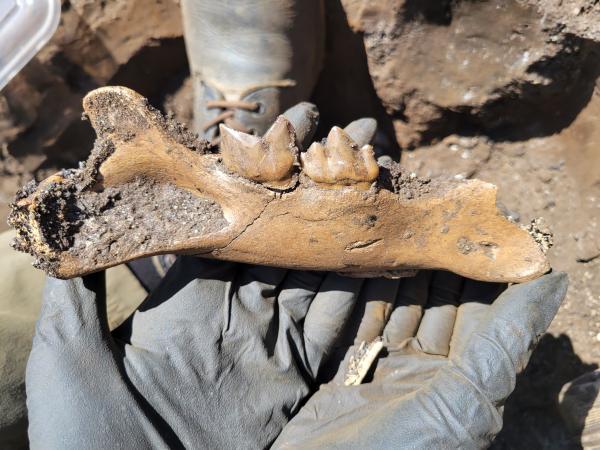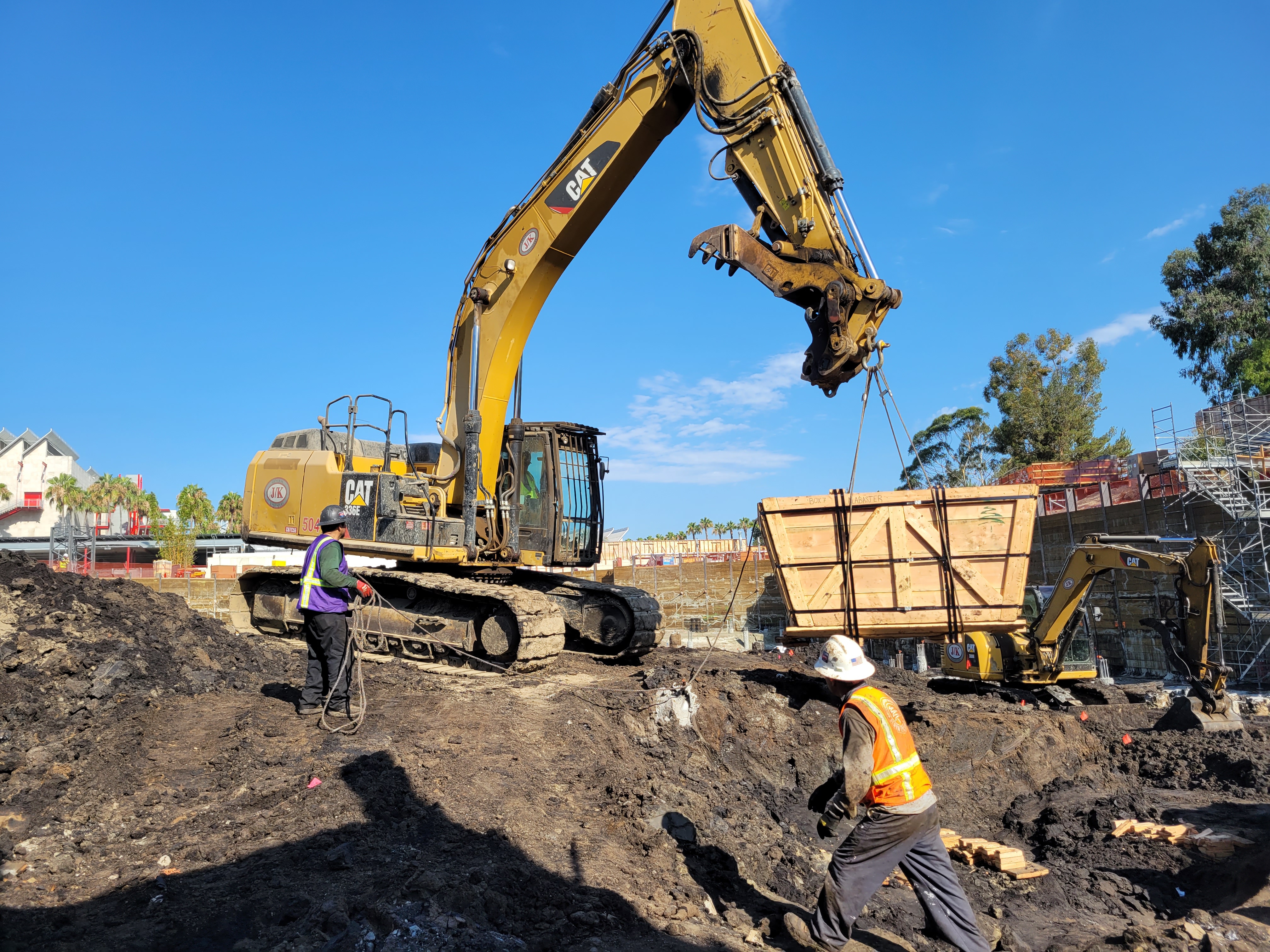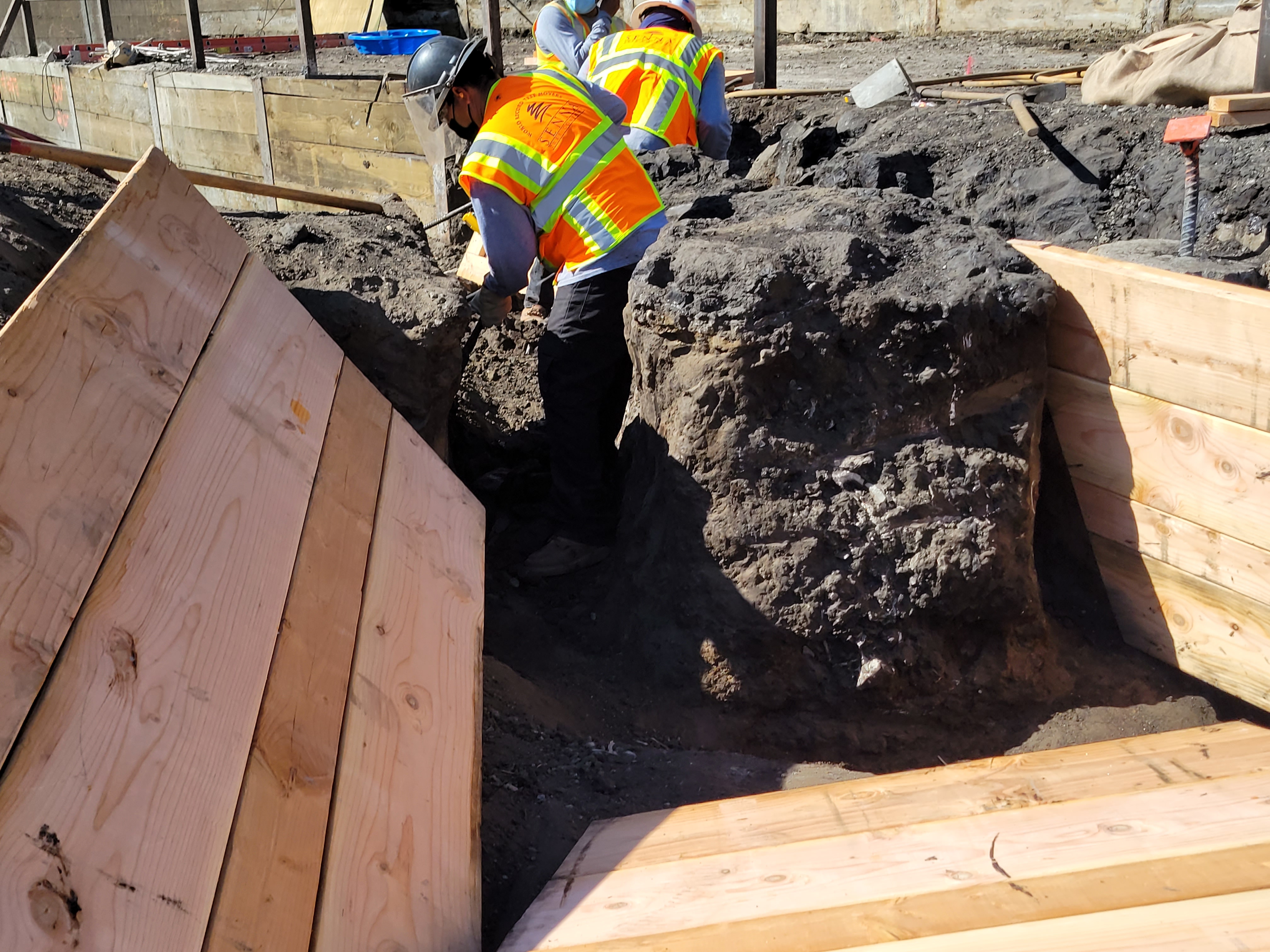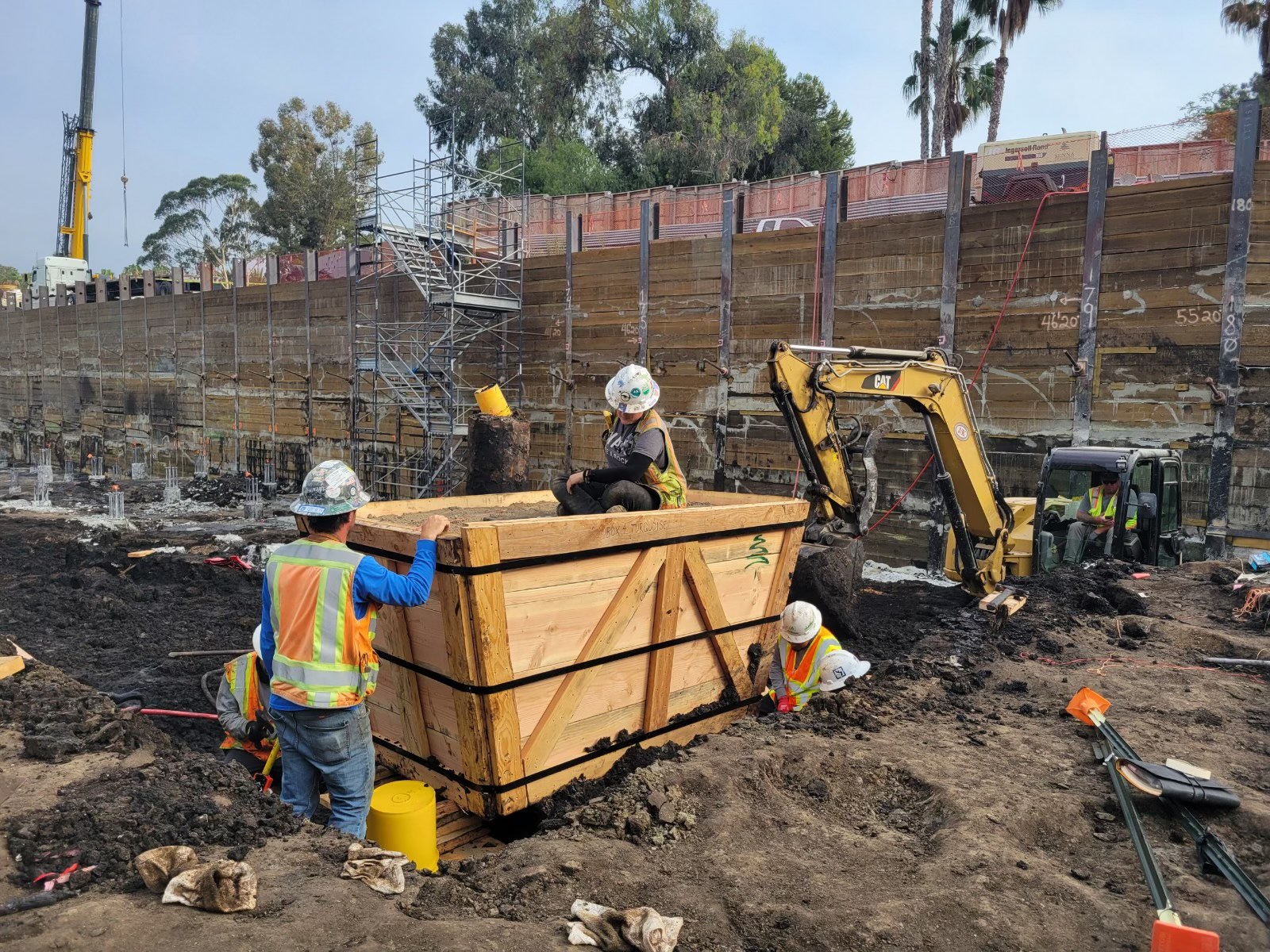Many Angelenos may remember Zed, a mammoth skeleton discovered in 2007 when LACMA was excavating the area that would become the Pritzker Parking Garage. The fossils were handed over to our neighbor, the La Brea Tar Pits & Museum, and today scientists and volunteers continue to work on cleaning and sorting through 23 wooden boxes of fossil deposits and 327 buckets of fossil material that were collected during that excavation.
As LACMA is situated on a site known for its paleontological riches, we anticipated the possibility of discovering additional paleontological fossils during the construction of our new building for the permanent collection. Sure enough, now that excavation for the David Geffen Galleries is underway, we found fossils! To learn all about the fossils uncovered so far, we chatted with Emily Lindsey and Regan Dunn, assistant curators at La Brea Tar Pits & Museum; CEO/CFO and principal archaeologist Molly Valasik, field director Ashley Leger, and field supervisor Cassidy Sharp with Cogstone Resource Management, LACMA's paleontological consultants; superintendent Alex Dremonas with Clark Construction, LACMA's general contractor for the new building; and Norm Doerges, with Aurora Development, LACMA's owner's representative and project manager.

What is the paleontological significance of this site?
Emily Lindsey, Assistant Curator, La Brea Tar Pits & Museum: It's an extension of the Rancho La Brea site, and this whole area is known to contain deposits from the late Pleistocene era, including saber-toothed cats, bison, giant ground sloth, American lions, all from the past 55,000 years. It's one of the most productive sites in the world, and arguably the most important to science. It's very rare to find sites that preserve bone along with soft tissues like plants. Plants are preserved in acidic soil, but acid dissolves bone, and here, the whole ecosystem is trapped together, from megafauna to small vertebrates, songbirds, insects to plants, seeds, pollen, and entire tree trunks. Generally, larger animals may be preserved in river plains, but plants are washed away, and while smaller ecosystems may be captured in caves, brought in by raptors and rodents, larger ones are generally not. The tar pit situation is one of the only places where you get holistic accumulation, and the asphalt itself both actively traps things in place and preserves fossils and their original tissues for future study. Animals wandered around for thousands of years, but every time one walked over the tar pits it got stuck there. A big herbivore trapped in the tar might attract a pack of dire wolves or a group of saber-toothed cats, so you get a dense accumulation of fossils. The asphalt is such a good preserving agent. The bones found here are not replaced with minerals as they are in other places. They are original bones, original plant and insect material. We can identify them and we can do very high-level molecular studies where we can precisely radiocarbon-date the materials, which can tell us where exactly that animal or plant was living. Analyzing stable isotopes tell us what the different animals were eating, how much precipitation was there at the time, migration information. We get to do a wide range of ecosystem-level and species-specific research.
Regan Dunn, Assistant Curator, La Brea Tar Pits & Museum: And the number of individual specimens is extraordinary. There is no other place on Earth with the number of saber-toothed cats, dire wolves, and more. We can look at individual variations on how they lived and died.
Emily: Here, with the regular accumulations of species over time, with thousands of individual specimens, we can study microevolution, climate change, and even paleopathology, which tells you about injuries and diseases in animals.
Regan: This site is so important that there is a geological time period named after it: Rancholabrean. So even if you find something in Florida dating to this time, it will be identified as being from the Rancholabrean Age.
How does research of that era inform current topics of interest?
Emily: The La Brea Tar Pits record covers the last major episode of global warming (when we were coming out of the Ice Age), when humans migrated to North America, and we can see what ecosystems looked like before humans and after. The animals this age is famous for are all gone, and that extinction brings up questions about the long-term impact of climate change, how humans impact individual species and the ecosystem, what the impact of losing large keystone animals is. None of these questions can be fully answered without a deeper perspective, answered by paleontology. So the La Brea Tar Pits site helps answer the most meaningful questions in our current climate crisis.
Regan: The specimens found in the site are representative of what's found at our museum, but every single specimen has new information, which is key to understanding the major changes in the environment. Finding the last-known saber-toothed cat is an important data point, because every unique specimen has a story to tell.

What are you finding in the field at the construction site?
Ashley Leger, Field Director, Cogstone Resource Management (LACMA's paleontological consultants): We're finding everything and anything from classic Ice Age tar pit deposits. We're finding the same animal groups that they have at the La Brea Tar Pits & Museum, from the same time period, the same formation. It's the exact same representation. The La Brea Tar Pits & Museum has the world's largest collection of Ice Age fossils, dating from roughly 10–50,000 years ago. When the fossils in Project 23 were found during the Pritzker Parking Garage excavation, it was astounding. Those fossils could possibly double their collection. Now there are as many boxes in this project, or more! It's incredible.

Has this project mostly yielded fossils from large, extinct animals?
Cassidy Sharp, Field Supervisor, Cogstone Resource Management: This project is yielding a wide variety of fossils ranging from extinct animals such as ground sloths, dire wolves, saber-toothed cats, and American lions to extant animals like coyotes and eagles. We've also excavated small animals, including rodents, in addition to well-preserved leaves and seeds, which give us a unique glimpse into the environment of Mid-Wilshire thousands of years before it became Museum Row.
Are there unique aspects to this project compared to other excavation projects you're involved in?
Ashley: Everything about this project is unique. Not only how predator-heavy the finds are, but also the sheer volume of fossils. We're working on another large construction project, and in five years we found 2,000 fossils. We're very excited about that, but we're finding a fossil here, a fossil there, and there can be a year between finds. With this project, there are literally findings all day, every day!
Cassidy: We have a partially excavated area where we are finding so many skulls. We don't typically find too many skulls in other areas, those are pretty rare. The area is 6'x3'x3', and so far we found maybe 15 or more skulls in that small space.
What makes skulls so rare to find?
Cassidy: Skulls are typically composed of thin bone and are not terribly robust, so over time they disintegrate or move and don't make it into fossil records. Animals have lots of bones, like vertebrae and ribs, and only one skull, so it's more common to find those other elements.
What's the excavation process for this project?
Norm Doerges, Aurora Development: The Environmental Impact Report (EIR) governing this project requires LACMA to hire paleontological consultants to monitor excavations, and extract, protect, stabilize, and remove any significant fossils that are uncovered during excavation, following the process outlined in the EIR and agreed by the Natural History Museum of Los Angeles County. At the start of excavations for the project, the process started with training sessions to increase our construction team's awareness of fossils and teach them how to work with our paleontological team in the event of discoveries. The paleontologists are physically present at the excavation, monitoring, and watching for subtle differences between fossils and soils as the excavators remove the dirt. If fossils are spotted, the excavation is paused, and a paleontologist investigates the area to determine the extent and nature of the find and how best to remove it.
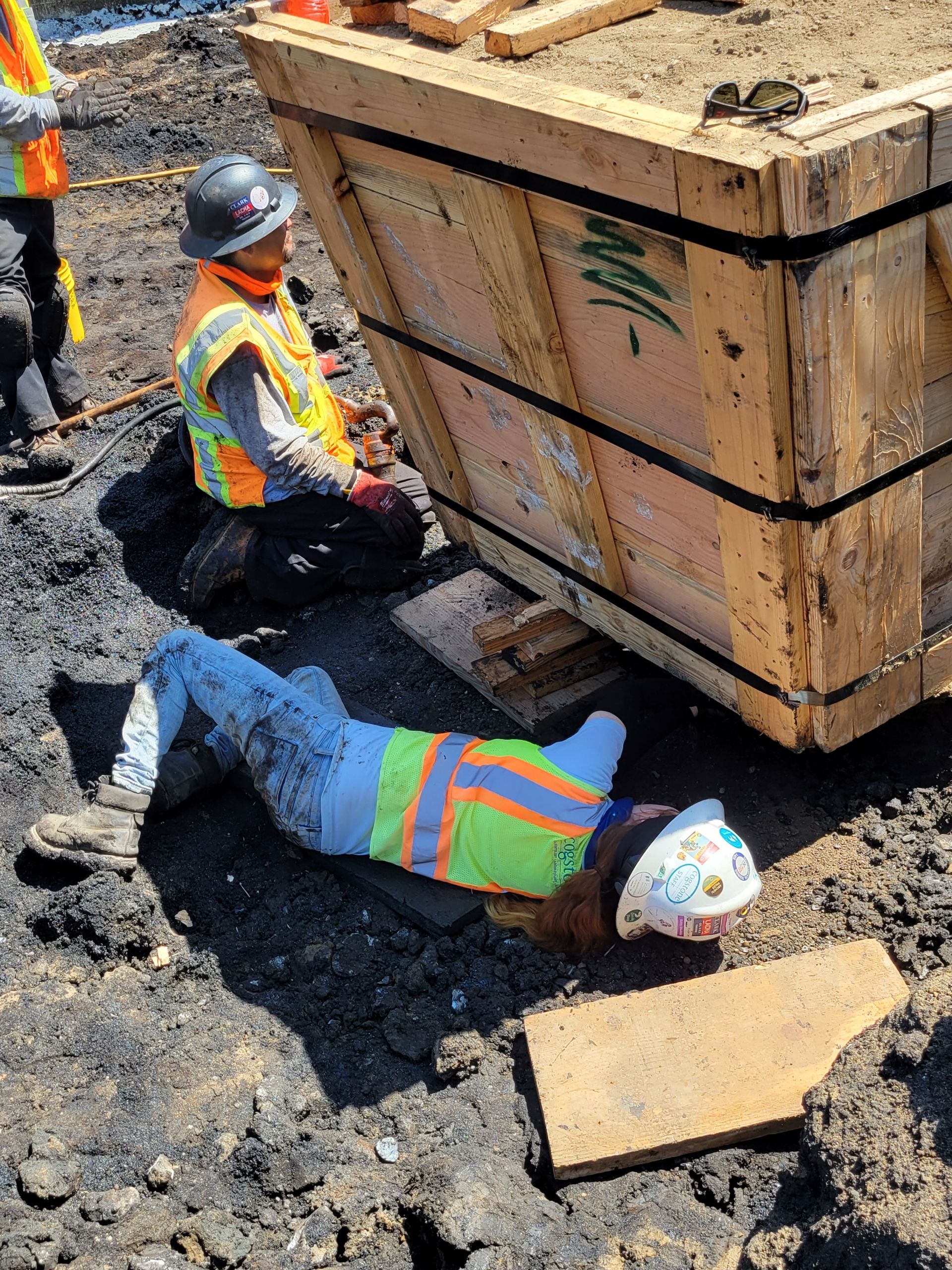
What happened when the first fossil deposits were found?
Cassidy: This is my childhood dream. I grew up going to the La Brea Tar Pits, and I wanted to be a paleontologist because of them. When I started on this project, I was monitoring during excavations, looking for fossils, waiting for a discovery to happen. They took a scoop out of an area and dropped it, and it rained fossils. A dire wolf mandible, a saber-tooth cat femur, a bison tooth. I was waiting for this day. It wasn't just one fossil, it was a sign of many more to come. I immediately stuck flags out there to mark the area.
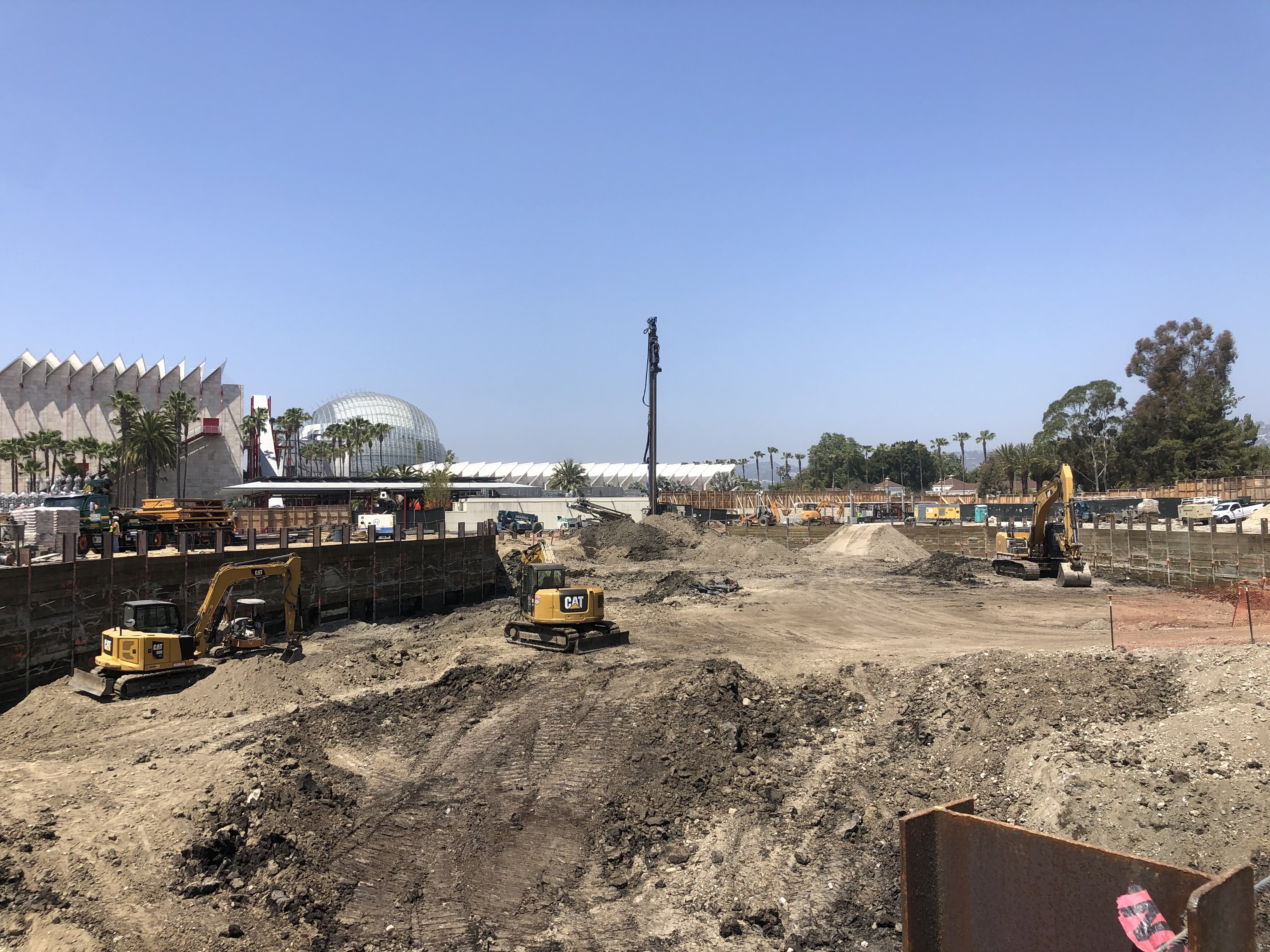
Knowing that this area has fossils, are there certain precautions taken while the operators are digging?
Alex Dremonas, Superintendent, Clark Construction: We conduct normal operations for excavation until the monitors wave for us to stop. From a digging perspective, we proceed with more caution with each scoop of the dirt so that we don't damage anything that might be underneath. Our operators work closely with the paleontologists so they just wave when they see something, and the operator will pull off the controls, wait, and see if we can continue or help the paleontologists by peeling something away delicately. The operators are skilled in controlling the bucket and can move as little as a couple of inches of dirt. It's a different strategy to digging on other projects, since it's more delicate. We use smaller equipment and use it more strategically where we know there are more bones.
How do you extract the fossils?
Cassidy: The tools totally depend on the preservation of the fossil and the sediment it's in. If it's hard, we use a hammer and chisel. If it's softer, we use dental tools and a brush. We use knives to dig through clay. It all depends. Here, there have been fossils in all kinds of sediment.
Do you catalogue what's coming out, or does that happen later?
Ashley: In the field, we do the best we can to preliminarily catalogue finds that come out individually. We trench and log what we're finding, but so much more will come out when the fossils are researched. We also log sediment and location data and take photographs.
What happens with construction while the paleontologists are extracting the fossils?
Norm: Discovery and extraction of fossils slow things down and we need to re-sequence the construction work to focus on other areas of the excavation and to work around the paleo team; whatever adjustments we can make to keep the work moving forward and make up for delays in some areas. Many re-sequencings are needed as more paleontological finds are discovered in various locations on the site. The paleo team has also made adjustments to their area of focus to open up areas of the site for construction work. It's a coordinated process and the goal is for the paleontologists to excavate the fossils very carefully and as quickly as possible, to minimize delays and keep the foundations construction moving forward.
Alex: We also have an operator there with the paleontologist to assist during fossil removal operations if they need it.
Have you been on other jobs where fossils were discovered?
Norm: Yes, our firm (Aurora Development) worked on the Pritzker Parking Garage when it was excavated. It was a similar experience to this in many ways—the process for monitoring and extraction methods of fossils was the same. During that project we encountered several large animals, whereas this time the finds are more of the "tar pit type" (something I learned from our paleontologist), which are more varied and scattered. We also recently found some well-preserved skulls, which are quite significant. We're quickly approaching the same quantity of finds as were encountered during Pritzker.
Alex: This is my first one, and it's exciting to see what we've uncovered. Working closely with Cogstone, they know more or less what they're finding, and so it's exciting to see them get excited.
Have any human artifacts been found?
Alex: No, and as part of the EIR process, representatives from the Kizh Nation are here, monitoring in a similar way to the paleontologists.
What excites you the most about these findings?
Molly Valasik, CEO/CFO and Principal Archaeologist, Cogstone Resource Management: When working with construction mitigation projects, fossils end up in a museum either on display or in the collection, for public access. They're visited by researchers from all over the world. They are being saved for a future generation, and it's significant. And if these were found in Kansas, it could be legally bulldozed. California is one of the few states with protection of fossils in place.
Cassidy: The preservation of the fossils is really incredible. There are leaves and beetles and saber-toothed cat canines and really huge bison femora, all in exceptional condition. We can learn a lot about what the Ice Age looked like here in Los Angeles.
The animal skeletons tend to be crowd-pleasers, but what can plant materials tell us?
Regan: Most of the plant fossils we find are of living species, living representatives of plants somewhere in the state. Much of what we find are woodland species, like juniper, manzanita, and oak. You can find those today, nearby. What we find interesting is how plants lived together in different time periods, and how they changed as the climate changed. As they sit there, plants record the ancient temperatures, climate, and precipitation. In tree rings you can see that year's growing season condition. You can unpack all that information and have a bottom-up perspective, showing what the animals ate, what their living conditions were like.
Emily: Plant fossils tell us what it was like right here in Hancock Park. They tell us that some plants moved in response to changing climate, and information about what factors they responded to, whether it was precipitation, maximum summer temperatures, minimum winter temperatures, the length of the dry season, is what we can use to plan for conservation needs today. It helps inform where we need to establish protective areas, where plants can live in a future warmer climate.
The site is obviously an incredible resource for science, and also special in that art and science coexist and are presented side by side.
Emily: So many artists have been inspired by the Rancho La Brea site. A number of local artists use our asphalt as media, including James Griffith and Carl Cheng [who was a recipient of LACMA's Art + Technology Grant], while other artists, such as Walton Ford, have featured our site as a subject in their work. We have also done a number of art and science events in partnership with LACMA, including walking tours and exhibitions. Hopefully this new discovery will present even more opportunities for collaboration!



